Women Leadership in Padmakanya Multiple Campus: An Empirical Case Study
DOI:
https://doi.org/10.3126/pprmj.v4i1.67684Keywords:
women leadership, recognition, masculine, feminine, academiaAbstract
The objectives of the study are to determine the recognition and assess the status of women leadership in the Padmakanya Multiple Campus in Kathmandu. This study adopted a descriptive research design and applied qualitative techniques with a case study approach. Primary data were collected using a purposive sampling technique. This study adopted an interview approach to get an experience of women. Data were analyzed based on thematic analysis. Women have a feminine leadership style, not a masculine style. Thus, women show a flexible and cooperative leadership style. Sometimes, women are dominated by men in leadership roles due to women’s non-directive style of leadership in the organization. Women’s leadership style is linked with their feminine traits and features. However, women leaders are committed, devoted, and dedicated to the organization besides being flexible. They tend to be tolerant, kind, and cooperative among leaders in academia. It can be concluded that female employees want to get leading roles and tackle difficulties and issues challenges within the organization. It was also concluded that female academics get the opportunities of leadership and create their own identities in the academic system; however, it is full of challenges. Women academics have the challenges of male domination, less cooperation, and teamwork at work, less power over their academic abilities, and a heavy workload.




